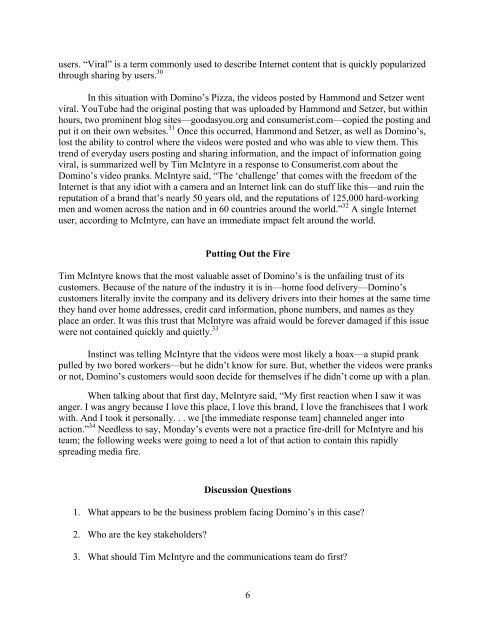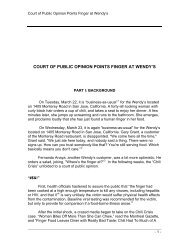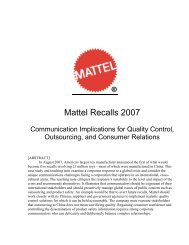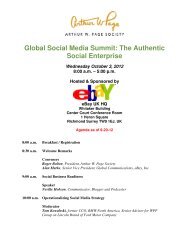Domino's “Special†Delivery: - The Arthur Page Society
Domino's “Special†Delivery: - The Arthur Page Society
Domino's “Special†Delivery: - The Arthur Page Society
Create successful ePaper yourself
Turn your PDF publications into a flip-book with our unique Google optimized e-Paper software.
users. “Viral” is a term commonly used to describe Internet content that is quickly popularized<br />
through sharing by users. 30<br />
In this situation with Domino’s Pizza, the videos posted by Hammond and Setzer went<br />
viral. YouTube had the original posting that was uploaded by Hammond and Setzer, but within<br />
hours, two prominent blog sites—goodasyou.org and consumerist.com—copied the posting and<br />
put it on their own websites. 31 Once this occurred, Hammond and Setzer, as well as Domino’s,<br />
lost the ability to control where the videos were posted and who was able to view them. This<br />
trend of everyday users posting and sharing information, and the impact of information going<br />
viral, is summarized well by Tim McIntyre in a response to Consumerist.com about the<br />
Domino’s video pranks. McIntyre said, “<strong>The</strong> ‘challenge’ that comes with the freedom of the<br />
Internet is that any idiot with a camera and an Internet link can do stuff like this—and ruin the<br />
reputation of a brand that’s nearly 50 years old, and the reputations of 125,000 hard-working<br />
men and women across the nation and in 60 countries around the world.” 32 A single Internet<br />
user, according to McIntyre, can have an immediate impact felt around the world.<br />
<br />
Putting Out the Fire<br />
Tim McIntyre knows that the most valuable asset of Domino’s is the unfailing trust of its<br />
customers. Because of the nature of the industry it is in—home food delivery—Domino’s<br />
customers literally invite the company and its delivery drivers into their homes at the same time<br />
they hand over home addresses, credit card information, phone numbers, and names as they<br />
place an order. It was this trust that McIntyre was afraid would be forever damaged if this issue<br />
were not contained quickly and quietly. 33<br />
Instinct was telling McIntyre that the videos were most likely a hoax—a stupid prank<br />
pulled by two bored workers—but he didn’t know for sure. But, whether the videos were pranks<br />
or not, Domino’s customers would soon decide for themselves if he didn’t come up with a plan.<br />
When talking about that first day, McIntyre said, “My first reaction when I saw it was<br />
anger. I was angry because I love this place, I love this brand, I love the franchisees that I work<br />
with. And I took it personally. . . we [the immediate response team] channeled anger into<br />
action.” 34 Needless to say, Monday’s events were not a practice fire-drill for McIntyre and his<br />
team; the following weeks were going to need a lot of that action to contain this rapidly<br />
spreading media fire.<br />
Discussion Questions<br />
1. What appears to be the business problem facing Domino’s in this case?<br />
2. Who are the key stakeholders?<br />
3. What should Tim McIntyre and the communications team do first?<br />
6














